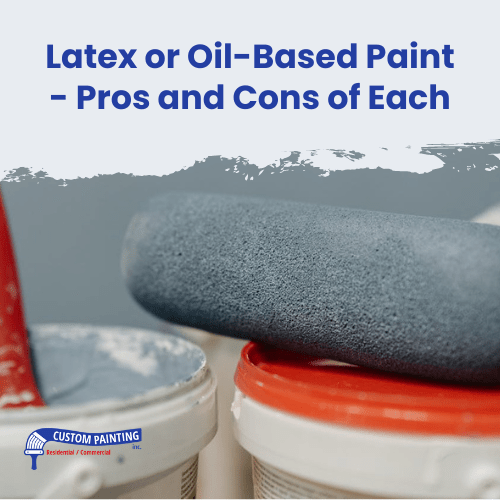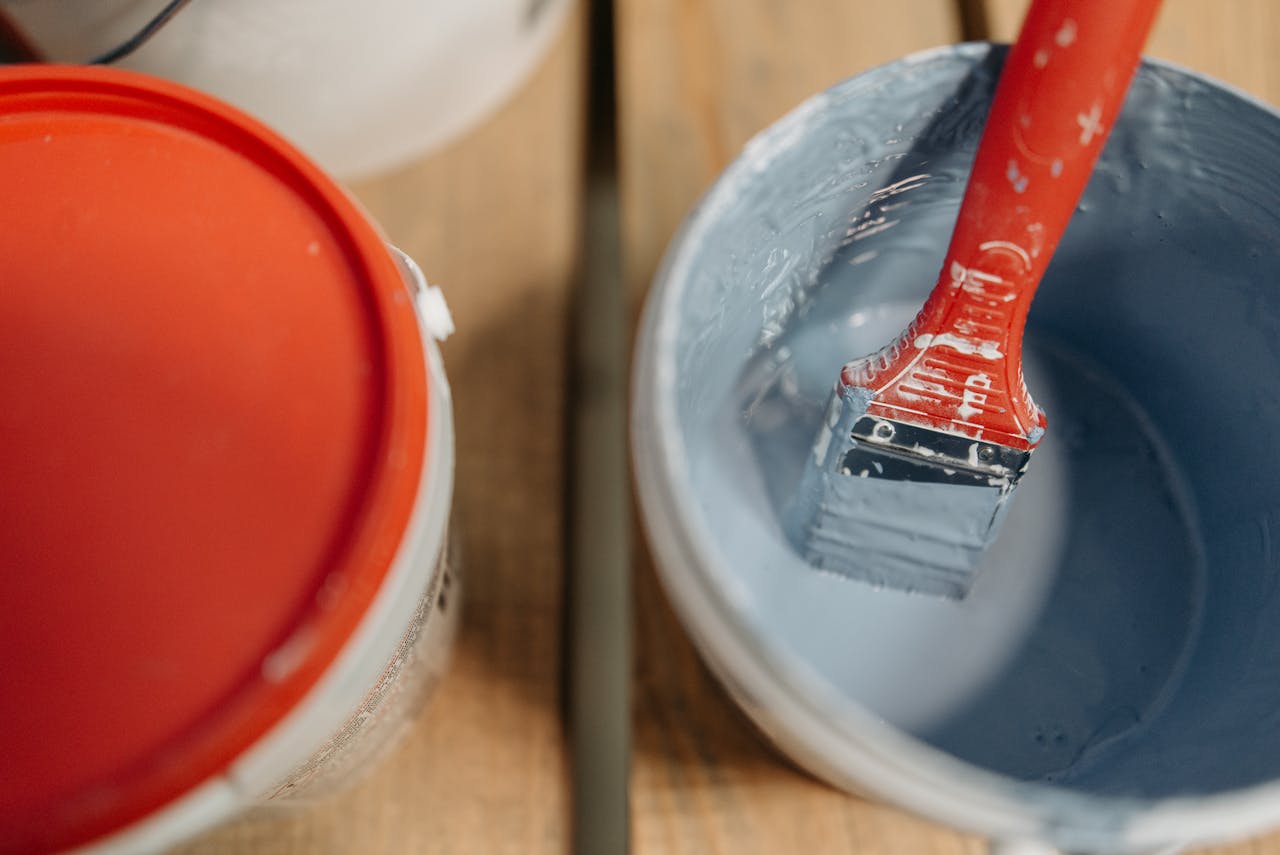When it comes time to select paint for a home project, one of the first decisions you’ll face is whether to use latex or oil-based paint. Each type has its own set of strengths and weaknesses that can affect the outcome and durability of your paint job. Understanding these differences is key to making an informed choice that aligns with your specific needs, whether you’re painting a bustling kitchen, a moisture-prone bathroom, or the exterior of your house. In this article, we’ll break down the pros and cons of each type of paint to help you decide which is best for your next project.
The Pros of Latex Paint
Latex paint, also known as water-based paint, is a popular choice for both DIY enthusiasts and professional painters alike. Its versatility and user-friendly properties make it suitable for a wide range of painting projects. Here are some of the key advantages of choosing latex paint for your next project:
- Easy Cleanup: One of the biggest advantages of latex paint is the ease of cleanup. Unlike oil-based paints, which require solvents like turpentine or mineral spirits for cleaning brushes, rollers, and spills, latex paint can be cleaned up with just soap and water.
- Quick Drying Time: Latex paint dries significantly faster than oil-based paints. This rapid drying can speed up painting projects, as it allows for quicker recoats. Typically, latex paint can dry to the touch within a few hours, and a second coat can often be applied the same day.
- Low Odor: Latex paint emits fewer odors than oil-based paints, which often have a strong solvent smell that can linger. The lower odor levels of latex make it a good choice for indoor projects, especially in enclosed spaces or areas with poor ventilation.
- Flexible and Less Prone to Cracking: As it dries, latex paint remains flexible, which allows it to expand and contract with the surfaces it covers without cracking. This makes latex paint particularly effective for exterior surfaces that are exposed to varying weather conditions.
- Resistant to Yellowing: Over time, oil-based paints can develop a yellow tinge, especially when used indoors or in areas with limited natural light. Latex paints maintain their color better and are less likely to yellow, ensuring a fresher appearance for longer.
- Environmentally Friendly: Latex paints are generally more environmentally friendly compared to oil-based paints. They contain lower levels of volatile organic compounds (VOCs), which can contribute to air pollution and respiratory problems.
The Cons of Latex Paint
While latex paint offers several appealing benefits, it also comes with some drawbacks that might influence your choice depending on the specifics of your painting project. Being aware of these limitations can help you make a more informed decision and ensure the best results for your needs. Here are some of the cons associated with latex paint:
- Less Adhesion on Certain Surfaces: Latex paint sometimes struggles to adhere to surfaces that are not properly prepared, especially if they are glossy or made from certain materials like PVC or metal. This can lead to peeling or chipping, requiring more intensive surface preparation or a specific type of primer.
- Weather Sensitivity: Although latex paint dries quickly, it is sensitive to temperature and humidity while drying. Painting in conditions that are too cold or too humid can affect the paint’s ability to dry properly, potentially leading to a subpar finish.
- Not as Durable in High-Traffic Areas: While modern latex paints are quite durable, they can still be less resistant to wear and tear compared to oil-based paints, particularly in high-traffic areas or on surfaces that undergo frequent cleaning.
- Poor Performance Over Oil-Based Paint: Applying latex paint directly over old oil-based paint can lead to poor adhesion and may require stripping the original layers before a successful application. This can add extra steps and complexity to the painting process.
- Limited Gloss Levels: Latex paints traditionally offer fewer options when it comes to high-gloss finishes. While there are semi-gloss and gloss latex paints available, they might not provide the same level of sheen as their oil-based counterparts, which could be a drawback for projects requiring a glossy finish.
The Pros of Oil-Based Paint
Oil-based paint, often chosen for its durability and rich finish, has been a preferred choice for many painting projects, especially where wear and tear are a concern. Despite the rise in popularity of latex paints, oil-based varieties continue to hold their ground due to several intrinsic advantages. Here are some of the key benefits that oil-based paint offers:
- Durability: One of the strongest advantages of oil-based paint is its durability. It creates a hard, enamel-like finish that is more resistant to scratching, chipping, and staining than latex paints. This makes it ideal for surfaces that require frequent cleaning or are subject to heavy use.
- Smooth Finish: Oil-based paints tend to leave a very smooth finish with fewer brush marks. The longer drying time allows the paint to level out after application, which is particularly beneficial when painting trim, doors, and cabinets for a professional look.
- Superior Adhesion: Oil-based paint has excellent adhesion properties, especially on difficult surfaces like metal or shiny, glossy surfaces. This superior sticking ability makes it an excellent choice for projects that involve more challenging materials.
- Moisture Resistance: This type of paint is highly effective at resisting moisture, making it a great choice for areas that are prone to dampness such as bathrooms and kitchens. The robust finish protects surfaces from steam and water damage better than most latex paints.
- Rich Colors: Oil-based paints are praised for their deep and vibrant colors. The paint’s formula allows it to maintain a rich and consistent hue, which often looks better for longer than some water-based alternatives, especially in vibrant or deep tones.
- Excellent for High-Traffic Areas: Given its durability and tough finish, oil-based paint is well-suited for high-traffic areas. It can withstand more wear and tear, making it a practical choice for floors, banisters, and any other areas that experience a lot of handling or foot traffic.
The Cons of Oil-Based Paint
Oil-based paint, while valued for its durability and quality finish, comes with certain drawbacks that might make it less suitable for some projects, especially those in residential interiors or areas requiring quick turnaround times. Here are the primary cons associated with oil-based paint:
- Long Drying Times: Oil-based paints take longer to dry compared to latex paints. This extended drying period can complicate scheduling for additional coats or completing the project, especially in environments where time is a constraint.
- Strong Odors and High VOCs: The solvents in oil-based paints emit strong odors and high levels of volatile organic compounds (VOCs). These can be harmful to health and the environment, requiring adequate ventilation during application and drying and potentially causing discomfort.
- Cleanup and Disposal Challenges: Cleaning up after using oil-based paint requires solvents such as turpentine or mineral spirits. These materials are not only harsher on the environment but also necessitate careful handling and disposal to avoid pollution and health risks.
- Tendency to Yellow Over Time: Oil-based paints are prone to yellowing as they age, particularly in areas with little natural light. This effect can alter the intended color and aesthetic of a paint job, leading to dissatisfaction and the need for more frequent repainting.
- Flexibility Issues: While oil-based paint is durable, it is also less flexible than latex paint. This lack of flexibility can lead to cracking and flaking as the painted surfaces expand and contract due to temperature changes or as the building settles.
- Environmental Concerns: Due to the high VOC content and the non-biodegradable nature of the solvents required for application and cleanup, oil-based paints pose greater environmental risks compared to their water-based counterparts.
Tips for Choosing Between Latex and Oil-Based Paint
Deciding between latex and oil-based paint is an essential step in any painting project, with each type offering distinct advantages and limitations. Here are some tips to help you choose the right paint for your needs, ensuring both durability and aesthetic appeal for your space.
Consider the Surface Type
Before selecting a paint type, consider the surface you will be painting. Oil-based paint is renowned for its superior adhesion on tricky surfaces such as metal or previously painted surfaces with high gloss finishes. It’s particularly useful for projects that require a tough, durable finish, like trim, furniture, or cabinetry. On the other hand, latex paint is ideal for general wall painting and large surface areas because of its ease of application and quick drying time.
Assess the Project Location
The location of your painting project plays a significant role in determining the type of paint to use. Latex paint, with its lower VOC levels and minimal odor, is better suited for indoor projects, especially in confined or poorly ventilated spaces. For exterior projects, oil-based paint can be a better choice due to its resistance to temperature changes and superior water repellency, which helps prevent mold and mildew in wet climates.
Think About Longevity and Maintenance
If longevity and ease of maintenance are top priorities, consider your options carefully. Oil-based paints generally offer a harder and more durable finish, making them suitable for high-traffic areas or surfaces that require frequent cleaning. However, they are prone to yellowing over time, especially indoors and in low-light areas. Latex paints remain vibrant and true to color for longer but may require more frequent touch-ups on heavily used surfaces.
Reflect on Finish Quality
The desired finish of your project can also guide your choice. Oil-based paints typically leave a smoother, more uniform finish that many professionals prefer for woodwork and fine details. They also come in higher gloss levels, which can be desirable for certain decorative effects. Latex paints have improved significantly and can offer a beautiful finish but might show more brush strokes or texture, depending on the application technique.
Evaluate Cleanup and Environmental Impact
Finally, the cleanup process and environmental impact should be considered. Latex paints are much easier to clean up, requiring only soap and water for brushes, rollers, and spills. This ease of cleanup, combined with the lower VOC emissions, makes latex a more environmentally friendly option. Oil-based paints require solvents for cleanup, pose higher VOC-related health risks, and have a greater environmental impact due to the chemicals involved.
Conclusion
Choosing the right type of paint for a project—whether latex or oil-based—requires a careful assessment of the specific demands of the task at hand. Understanding the nuances of these types of paint will help ensure that you select the best paint for your needs, balancing practicality with aesthetic outcomes. For anyone seeking further guidance or professional painting services, Custom Painting, Inc. is here to help. To discuss your next painting project or learn more about our services, call us at (925)-294-8062 or fill out our Contact Form.



